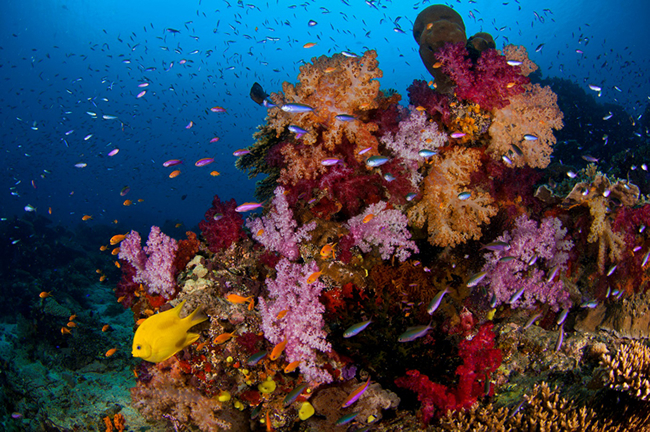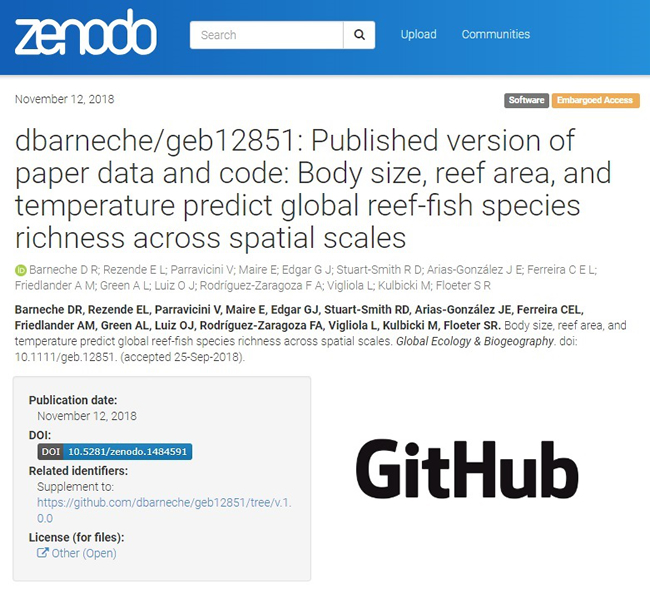WHY ARE THERE MORE SPECIES PACKED IN SOME PLACES THAN OTHERS?
AND WHY DOES IT MATTER?
Diego R. Barneche & Sergio R. Floeter

Fig. 1 – Reef fish species packing at Taveuni, Fiji (Photo: J.P. Krajewski).
THE QUESTION
Biodiversity – the richness of species found at a given location – is critical to maintain ecological processes and the benefits provided to
humans by natural ecosystems. It is therefore extremely important to understand what causes biodiversity to vary in space and time. A
century-old quest in this line of enquiry is to explain why some places pack so much more species per unit area than others. Researchers
have long proposed that the richness of species at a given site depends both on local biological interactions among inhabitant species,
such as predation and competition, as well as regional factors such as the available ‘pool’ of colonizers in the whole region which
supposedly are formed over millions of years through complex evolutionary processes. There is a heated debate on the relative
importance of local versus regional processes in shaping species richness. However, disentangling their relative contributions remains a
challenging task for ecologists. Are there limits for the maximum number of species occurring in a place? What factors could explain the
centenary question above?
Reefs are among the most threatened ecosystems on Earth, primarily due to overfishing, habitat degradation, and climate change. Reefs
comprise a bewildering richness of species (see Fig. 1) which provide multiple services to humans, most notably food security and
shoreline protection against extreme weather events. The number of fish species living in tropical coral reefs increases rapidly as the
spatial scale increases from small coral patches to whole islands, culminating in a large regional richness. In subtropical rocky reefs,
however, fishes accumulate at a much slower pace, resulting in a substantially lower regional richness.
Some candidate factors may explain this variation in fish biodiversity among different reefs. For instance, tropical coral reefs are for
instance primarily characterized by many species of smaller size, warm waters, and lots of three-dimensional space for fishes to explore
built by the corals themselves, whereas subtropical rocky reefs are composed of larger species inhabiting colder waters with relatively
less structural complexity in their habitats. Additionally, isolation might limit the number of potential colonizers, and fishing might hinder
the long-term establishment of species on a given reef. We thus set out to investigate which of these factors could collectively explain the
observed gradient in fish species richness among reefs all over the globe. Based on our findings, we proposed conceptual mechanisms
that might explain such gradient.
WHAT DID WE DO AND HOW?
We assessed reef-fish richness at different spatial scales by compiling of one of the largest global databases of underwater visual
censuses, encompassing over 13,000 visual transects spread through 14 tropical biogeographic regions. In these visual censuses,
researchers count the number of fish individuals, their species identity, and tally their size.
This effort was conducted by a team of international scientists and took two decades to be compiled (data available at:
https://zenodo.org/record/1484591#.W_qy0zhKjIW; Fig. 2). We then analyzed the data statistically by testing whether the average fish body
size, reef area, isolation, temperature, and human-made impacts are correlated with species richness at each spatial scale. We also
tested whether the number of species per sample-transect, also known as “species packing”, correlated with the total pool of colonizing
species in their respective regions, also known as “biogeographic provinces”.
WHAT DID WE FIND OUT?
Body size has the strongest effect on species richness across all spatial scales: species‐rich provinces exhibited diverse assemblages
of small‐bodied species, whereas species-poor provinces were represented by less diverse assemblages composed of larger species
with greater dispersal capacity. Richness was also positively correlated with reef area and temperature at all spatial scales that we
analyzed, while human-made impacts and isolation were mostly not correlated with species richness in our analysis. Species packing at
the scale of small transects was correlated with species richness at the province level.
WHY DOES IT MATTER AND WHAT IS NEXT?
Our findings support three main bodies of existing ecological theories. The first links the home range of species to their accumulation
across space, also known as “species–area relationships”. The second predicts that warmer temperatures increase the rate with which
new species arise over time, increasing the regional pool of colonizers and potentially the number of species that are packed at small
scales. The third predicts that larger areas will inevitably harbor more species. Building on our results and this theoretical knowledge, we
hypothesize that in less diverse areas species are not only generally larger but also more dispersive, such that the turnover, which is the
replacement, of species across space is not strong, and thus the sum of species in the regional pool is relatively smaller. This suggests
that changes in the composition of local‐scale assemblages may be informative of responses occurring at larger scales.
Now we have a better understanding of what factors contribute to the accumulation of reef fishes across spatial scales globally.
Understanding that body size, reef area and temperature are all factors affecting species richness is important to define better
management rules. For example, habitat degradation reduces the suitability for small species whereas fishing reduces the number of
larger species. Our results indicate that both impacts will affect the pool of colonizers in the long run. The more we know about the drivers
of variation in species richness, the more likely we will be able to predict how marine biodiversity and their services may be in the near
future.
FULL PAPER:
Barneche, D.R., Rezende, E.L., Parravicini, V., Maire, E., Edgar, G.J., Stuart-Smith, R.D., Arias-González, J.E., Ferreira, C.E.L., Friedlander,
A.M., Green, A.L., Luiz, O.J., Rodríguez-Zaragoza, F.A., Vigliola, L., Kulbicki, M. & Floeter, S.R. Body size, reef area, and temperature predict
global reef-fish species richness across spatial scales. Global Ecology and Biogeography, DOI: 10.1111/geb.12851

Fig. 2 – Dataset and codes available at GitHub and Zenodo. |


